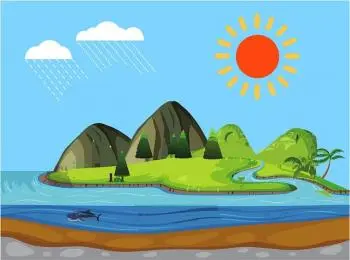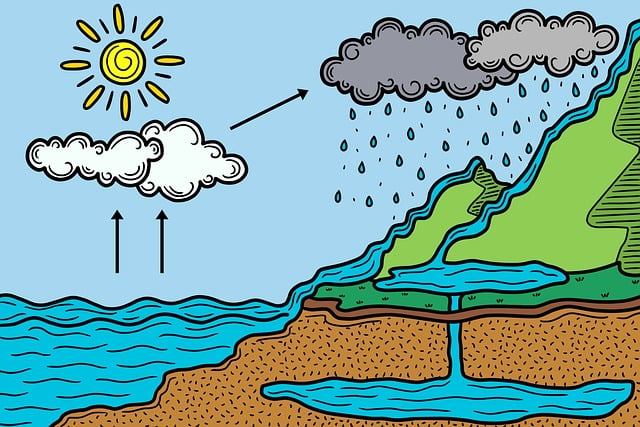
The water cycle, also known as the hydrological cycle, is a fundamental process that governs the distribution and availability of the most essential resource for life on Earth: water.
Over billions of years, this cycle has been a constant element on our planet, allowing water to circulate uninterrupted through its different physical states and locations.
From the evaporation of surface water to cloud formation, precipitation and subsequent runoff, the water cycle is an endless dance that supplies nature and meets human needs, while playing a vital role in regulating the environment. climate and the formation of landscapes.
Through this article, we thoroughly explore this natural process, its importance to life on Earth, and the challenges it faces in the modern world.
Drawing and stages of the water cycle
 The water cycle involves a series of processes, stages and changes of state as water moves through the Earth and its atmosphere.
The water cycle involves a series of processes, stages and changes of state as water moves through the Earth and its atmosphere.
This drawing of the water cycle perfectly illustrates all the stages of this process. Below I explain step by step how each of the phases of the water cycle develops:
1. Evaporation
The cycle begins with evaporation. Solar radiation warms water surfaces, such as oceans, lakes and rivers, as well as the moisture present in soil and plants. This heat transforms liquid water into water vapor, which rises into the atmosphere.
2. Condensation
As water vapor rises in the atmosphere, it cools and condenses into small water droplets or ice crystals. These water droplets form clouds.
3. Precipitation
When water droplets in clouds become large enough, they fall to Earth as precipitation, which can be rain, snow, hail, or sleet. This is the process by which water returns to the earth's surface.
4. Runoff
Precipitation can follow several paths once it reaches Earth. Some droplets can infiltrate the soil and become groundwater. Others can flow over the surface, forming streams and rivers that eventually flow into oceans and lakes.
5. Storage
Some of the water that reaches the surface is temporarily stored in lakes, reservoirs, aquifers and glaciers. This water can remain in these reservoirs for long periods before rejoining the cycle.
6. Perspiration
Plants absorb water from the soil through their roots and release it as water vapor through their leaves in a process known as transpiration. This water also enters the atmosphere.
7. Infiltration
When water penetrates the soil, this process is called infiltration. Infiltrated water can recharge into underground aquifers or flow slowly through the land to eventually feed rivers and streams.
The importance of the water cycle
The water cycle is essential to sustaining life on Earth and maintaining healthy ecosystems.
Here are some key reasons why the water cycle is vitally important:
-
Drinking water supply : The water cycle is the main source of drinking water for humans and animals. Through treatment and purification processes, we can take advantage of water from rivers, lakes and aquifers for domestic, agricultural and industrial use.
-
Sustaining ecosystems : Terrestrial and aquatic ecosystems depend on the water cycle for their survival. Rivers and lakes provide habitats for a variety of species, while terrestrial vegetation draws on water to grow and thrive.
-
Climate regulation : The water cycle plays a crucial role in climate regulation. Evaporation and transpiration help cool the Earth, while the release of heat during cloud condensation can have a warming effect. Additionally, air currents transport moisture through the atmosphere, influencing regional weather patterns.
-
Sources of hydroelectric energy : The water cycle is the basis of hydroelectric energy generation. Harnessing the kinetic energy of moving water, hydroelectric plants generate electricity, a clean and renewable source of energy.
-
Landscape formation : The water cycle plays an important role in landscape formation. Erosion caused by water runoff can shape mountains, valleys and canyons over millions of years.
Challenges in the water cycle
Despite its vital importance, the water cycle faces significant challenges today:
-
Water Pollution : Water pollution, whether from agricultural chemicals, industrial waste, or human waste, can have devastating effects on water quality and the health of aquatic ecosystems.
-
Water scarcity : In many regions of the world, freshwater availability is limited and demand for water for human and agricultural use exceeds supply. This has led to water scarcity issues that threaten water security.
-
Climate change : Climate change is affecting the water cycle in various ways. Precipitation patterns are changing, which may result in prolonged droughts and sudden, heavy rainfall. Rising temperatures also speed up evaporation.
-
Overuse of water resources : Overexploitation of aquifers and excessive extraction of water from rivers and lakes for agricultural and industrial purposes can deplete water resources and damage aquatic ecosystems.
Conclusions
The water cycle is an essential process for life on Earth. Through evaporation, condensation, precipitation, and other processes, water continually moves and is recycled, providing drinking water, ecosystem support, climate regulation, and much more.
However, the water cycle faces significant challenges due to pollution, water scarcity, climate change, and overuse of water resources.